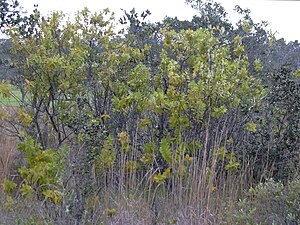Hawaiian tropical dry forests
| Hawaiian tropical dry forests | |
|---|---|

|
|
| Ecology | |
| Biome | Tropical and subtropical dry broadleaf forests |
| Borders | Hawaiian tropical low shrublands, Hawaiian tropical rainforests and Hawaiian tropical high shrublands |
| Geography | |
| Area | 6,600 km2 (2,500 sq mi) |
| Country | United States (Hawaii) |
| Conservation | |
| Conservation status | Critical/Endangered |
| Global 200 | Yes |
Coordinates: 21°N 157°W / 21°N 157°W
The Hawaiian tropical dry forests are a tropical dry broadleaf forest ecoregion in the Hawaiian Islands. They cover an area of 6,600 km2 (2,500 sq mi) on the leeward side of the main islands and the summits of Niʻihau and Kahoʻolawe. These forests are either seasonal or sclerophyllous. Annual rainfall is less than 127 cm (50 in) and may be as low as 25 cm (9.8 in); the rainy season lasts from November to March. Dominant tree species include koa (Acacia koa), koaiʻa (A. koaia), ʻakoko (Euphorbia spp.), ʻōhiʻa lehua (Metrosideros polymorpha), lonomea (Sapindus oahuensis), māmane (Sophora chrysophylla), loulu (Pritchardia spp.), lama (Diospyros sandwicensis), olopua (Nestegis sandwicensis), wiliwili (Erythrina sandwicensis), and ʻiliahi (Santalum spp.). Endemic plant species in the dry forests include hau heleʻula (Kokia cookei), uhiuhi (Caesalpinia kavaiensis), and Gouania spp. The palila (Loxioides bailleui), a Hawaiian honeycreeper, is restricted to this type of habitat.
...
Wikipedia
